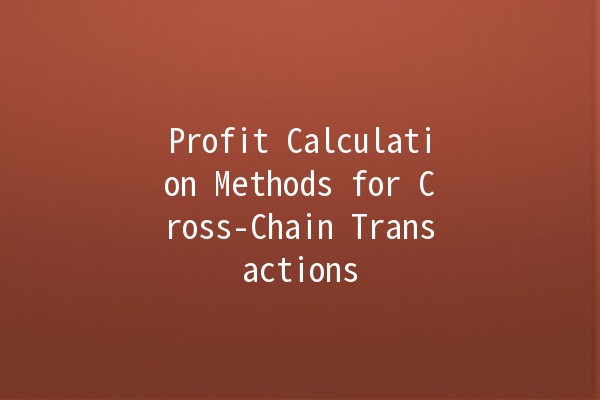
In the rapidly evolving world of blockchain technology, crosschain transactions have emerged as a vital topic of discussion and implementation. Interoperability between different blockchains allows for greater flexibility and efficiency in transferring assets. Understanding how to calculate profits from these transactions is crucial for anyone involved in the crypto space, be it traders, investors, or enthusiasts. This article dives deep into the methods for calculating profits from crosschain transactions while providing practical tips to enhance productivity and effectiveness.
Understanding CrossChain Transactions
Crosschain transactions refer to the ability to transfer assets or data between different blockchain networks. This capability is essential in the decentralized ecosystem, where various chains may operate under distinct protocols, governance models, and functionalities. Crosschain technology enables users to transact seamlessly without needing a centralized intermediary.
The Importance of Profit Calculation
Calculating the profit from crosschain transactions is critical for several reasons:

Basic Profit Calculation Formula
The fundamental formula for calculating profit in a business context is:
\[ \text{Profit} = \text{Total Revenue} \text{Total Costs} \]
In the context of crosschain transactions, total revenue will consist of the value obtained from the transaction in the desired asset, while total costs include transaction fees, slippage, and any conversion costs incurred during the process.
Key Techniques for Calculating Profit from CrossChain Transactions
Transaction fees vary greatly depending on the blockchain being utilized. For example, Ethereum can have fluctuating gas fees based on network congestion. It is crucial to include these fees in your profit calculations.
Example:
Suppose you are transferring an asset worth $1,000 from Ethereum to Binance Smart Chain (BSC). If the transaction fee on Ethereum is $50 and on BSC it’s $20, your total fees are $
Price slippage occurs when the execution price of a transaction differs from the expected price, typically due to market volatility or lack of liquidity. This factor can significantly impact profit calculations.
Example:
If you're trading 10 ETH for a stablecoin and anticipate receiving $30,000, but due to slippage, you only receive $29,500, your adjusted profit calculation must account for this difference, affecting the final profit margins.
Market volatility influences the final profit from crosschain transactions. Keeping track of market trends can help traders time their transactions better.
Practical Tip:
Utilize analytical tools and platforms that provide realtime data on market conditions. Implement alerts based on price changes that may indicate favorable conditions for a transaction.
Using crosschain platforms and tools can facilitate smoother transactions and may reduce costs significantly. Platforms like Thorchain and Polkadot allow for easier asset transfers between different blockchains with builtin optimizations.
Example:
If using a protocol that combines assets from different blockchains automatically, it might reduce costs substantially while providing competitive exchange rates. Track these lower fees when calculating profits.
Many blockchain networks offer liquidity incentives or yield farming opportunities, which can significantly affect your overall profit from crosschain transactions.
Example:
If you provide liquidity in a crosschain swap and earn a 10% yield annually, this should be factored into your profit calculations as additional income resulting from your transaction.
FAQ Section
Q1: How do I calculate profit when dealing with multiple currencies in crosschain transactions?
A1: Calculating profit across multiple currencies involves converting assets into a common currency for accurate value assessment; this is often done using an average market exchange rate. Consider transaction fees and currency exchange rates, then apply the profit formula as described above.
Q2: What platforms can I use for efficient crosschain transactions?
A2: Platforms such as Cosmos, Polkadot, and AnySwap facilitate crosschain exchanges. Always compute the total costs before engaging in transactions on these platforms, including any fees charged.
Q3: Is it possible to minimize fees during crosschain transactions?
A3: Yes, by choosing less congested networks, using gas optimization tools, and timing transactions based on average fees rather than peak times, you can reduce transaction costs effectively. Track and analyze historical fee data for more informed decisions.
Q4: How do I manage risks associated with crosschain transactions?
A4: Managing risks involves setting strict stoploss orders, only investing what you can afford to lose, and diversifying your investment portfolio across different assets to mitigate potential losses from any single transaction.
Q5: What are the tax implications of crosschain transactions?
A5: Tax implications can vary based on jurisdiction and the nature of the transaction. It's advisable to keep detailed records of all transactions, including fees paid, as these may be necessary for tax reporting.
Q6: How can I track my crosschain transaction history effectively?
A6: Utilise blockchain explorers for each specific chain and utilize tracking software or portfolio management tools that integrate with multiple blockchains. This allows for a consolidated view of your crosschain transaction history and profitability.
al Thoughts
Calculating profits from crosschain transactions involves considering multiple factors such as transaction fees, slippage, market conditions, and the use of advanced tools. By leveraging the strategies mentioned above and remaining informed about market dynamics, traders and investors can enhance their profitability in this complex but rewarding arena of the blockchain landscape.
Understanding these aspects not only improves decisionmaking but also paves the way for a more proficient approach to trading and investment in the rapidly evolving world of cryptocurrencies.

